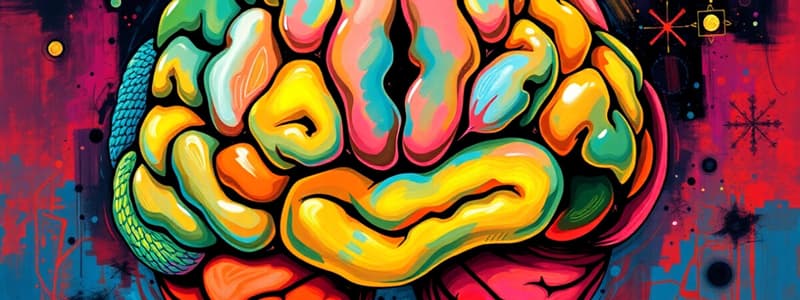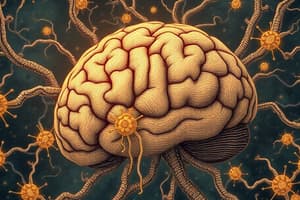Podcast
Questions and Answers
Which statement about brain hemispheres is accurate?
Which statement about brain hemispheres is accurate?
- Both hemispheres work together for most complex tasks. (correct)
- Each hemisphere of the brain works independently for all tasks.
- The right hemisphere is solely responsible for logical reasoning.
- The left hemisphere is responsible for creative tasks.
What is true about brain development?
What is true about brain development?
- Neural pathways do not change after a certain age.
- Brain development is a lifelong process. (correct)
- Brain development is complete by age 18.
- All brain functions stabilize in childhood.
What does current research say about learning styles?
What does current research say about learning styles?
- Learning effectiveness is influenced by various factors, not distinct styles. (correct)
- Different styles yield the same outcomes in education.
- Distinct learning styles greatly influence how individuals learn.
- Learning styles are scientifically proven to exist.
Which statement about brain injuries is correct?
Which statement about brain injuries is correct?
What is the reality regarding the concept of being left-brained or right-brained?
What is the reality regarding the concept of being left-brained or right-brained?
How should natural talent be understood?
How should natural talent be understood?
Which statement about trauma recovery is true?
Which statement about trauma recovery is true?
What is incorrect about the belief that the brain only uses 10% of its capacity?
What is incorrect about the belief that the brain only uses 10% of its capacity?
Flashcards
Negative Self-Perceptions
Negative Self-Perceptions
Inaccurate beliefs about one's brain capabilities affecting motivation and confidence.
Unfounded Claims
Unfounded Claims
Assertions of 'proven' methods without scientific backing, often supported by neuromyths.
Educational Misconceptions
Educational Misconceptions
Flawed strategies adopted by educators due to acceptance of neuromyths.
Misinformation Impact
Misinformation Impact
Signup and view all the flashcards
Evaluating Neuromyths
Evaluating Neuromyths
Signup and view all the flashcards
Neuromyths
Neuromyths
Signup and view all the flashcards
Brain Hemisphere Function
Brain Hemisphere Function
Signup and view all the flashcards
Brain Development
Brain Development
Signup and view all the flashcards
Learning Styles Myth
Learning Styles Myth
Signup and view all the flashcards
Brain Plasticity
Brain Plasticity
Signup and view all the flashcards
Left-brained vs Right-brained
Left-brained vs Right-brained
Signup and view all the flashcards
Natural Talent
Natural Talent
Signup and view all the flashcards
10% Brain Use Myth
10% Brain Use Myth
Signup and view all the flashcards
Study Notes
Introduction to Neuromyths
- Neuromyths are widespread, often inaccurate beliefs about the brain and how it functions.
- These beliefs often contradict scientific evidence and can impact educational practices, parenting, and personal development.
- Neuromyths often arise from simplifying complex neurological processes into easily digestible, but sometimes misleading, statements.
- The prevalence of neuromyths highlights a need for accurate brain science communication and critical thinking skills.
Common Neuromyths
- Myth: Using only one side of the brain.
- Reality: Both hemispheres of the brain work together for most complex tasks, though certain functions are primarily associated with one side.
- Myth: The brain is fully developed by a certain age.
- Reality: Brain development continues throughout life, with ongoing changes in synaptic connections and neural pathways.
- Myth: Specific learning styles exist and influence optimal learning strategies.
- Reality: Research does not support the existence of distinct learning styles.
- Learning effectiveness emerges from various factors, including prior knowledge, cognitive strategies, and individual differences.
- Myth: Brain injuries cannot be recovered from.
- Reality: The brain has a remarkable capacity for plasticity, allowing for recovery and adaptation following injury.
- Myth: People are either left-brained or right-brained.
- Reality: People use both hemispheres of their brain and the distinction is a simplification rather than a scientific reality.
- Myth: Some people are naturally 'gifted' or 'not-gifted'.
- Reality: Natural talent is a complex issue involving innate ability, acquired knowledge, and motivation, all of which can influence cognitive ability.
- Myth: Trauma to the brain cannot be reversed.
- Reality: Brain plasticity, the brain's capacity to change its structure and function, enables certain forms of recovery from injury.
- Myth: The brain only uses 10% of its capacity.
- Reality: This myth is entirely false. The brain is constantly active, using nearly all its parts.
Impact of Neuromyths
- Misinformed Strategies: Neuromyths can lead to the implementation of ineffective educational strategies.
- Misplaced Expectations: Parents and educators may have unrealistic expectations about development based on misinterpretations.
- Negative Self-Perceptions: Individuals might internalize inaccurate beliefs about their own brain capabilities, impacting motivation and confidence.
- Unfounded Claims: Neuromyths can underpin claims of 'proven' methods with little or no scientific grounding.
- Educational Misconceptions: Neuromyths can cause educators to adopt strategies that are based on flawed or incomplete models of the brain.
- Misinformation regarding brain health and fitness: Misconceptions that are not substantiated by scientific evidence can negatively impact brain health and overall cognitive functioning.
Critically Evaluating Neuromyths
- Identify claims or statements about brain functions.
- Analyze the scientific evidence behind the claim.
- Look out for oversimplifications or anecdotes.
- Cross-reference information with multiple reliable sources.
- Examine the source and their credibility.
Studying That Suits You
Use AI to generate personalized quizzes and flashcards to suit your learning preferences.




